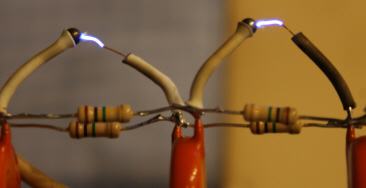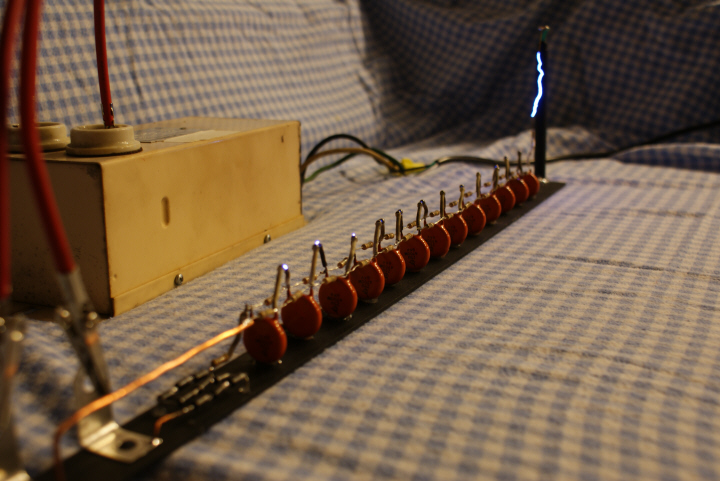Marx generators are the simplest voltage multipliers out there, as they contain nothing but capacitors, wire and resistors.
Below is a schematic of a marx generator and as you can see it contains only capacitors and resistors. The diode and transformer are the power supply. Notice the little ball shaped things with the sparks going through them, those are the spark gaps and they are what makes the generator work. Also notice that the first one is smaller.

At first all the capacitors are charged up through the resistors; something that takes a little while because the resistors are often of very high value. The resistors I used were one million ohms while the capacitors I used were rated at 6,000V, 4.7nF. They are only being charged to 5000Vrms, but they don’t seem to mind the 7000V peak they get. Although a marx can be constructed very easily, it typically requires a minimum of 9kV for reliable operation.
 When the capacitors reach a high enough charge the voltage across the first spark gap becomes so great that the air breaks down and the charge jumps across. Since the spark gaps are arranged in a zigzag configuration, this puts the next capacitor in series with the last because of this the voltage has doubled. It then easily sparks over the next gap. All the gaps then fire in a cascade which creates a very high positive or negative voltage across the entire stack.
When the capacitors reach a high enough charge the voltage across the first spark gap becomes so great that the air breaks down and the charge jumps across. Since the spark gaps are arranged in a zigzag configuration, this puts the next capacitor in series with the last because of this the voltage has doubled. It then easily sparks over the next gap. All the gaps then fire in a cascade which creates a very high positive or negative voltage across the entire stack.
The spark gaps in a marx generator should be as round as possible, otherwise the electricity will leak away via corona discharge. The spark gaps in my marx generator were made by soldering little iron balls to the capacitors’ leads, then some heat shrink tubing was placed around the wire lead.

In order for the marx generator to work properly the first spark should occur at the first gap, so to encourage sparking the balls in the first 3 gaps were replaced with a piece of hair thin wire. Since electricity prefers to leave pointy objects rather than round ones, this made sure sparks occurred on the first few gaps.
Below we have the obligatory spark pictures and youtube video. Every pop is a spark, but the camera misses quite a few of them. ∎




Leave a Reply